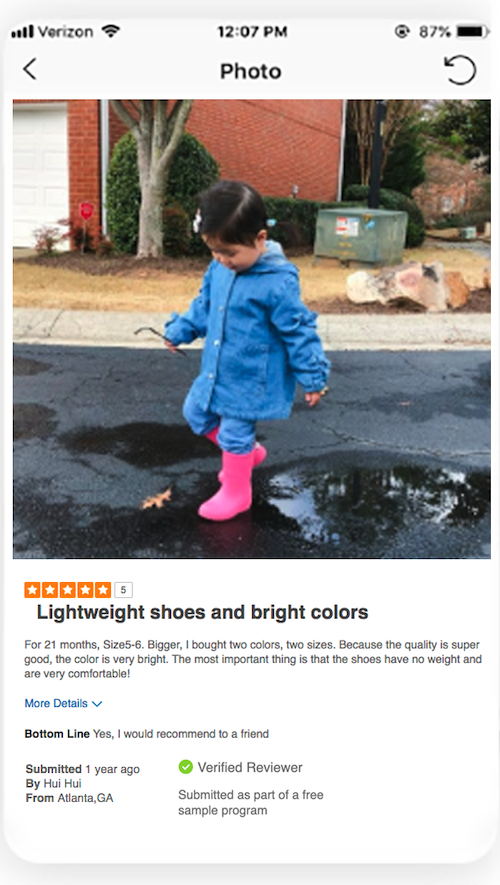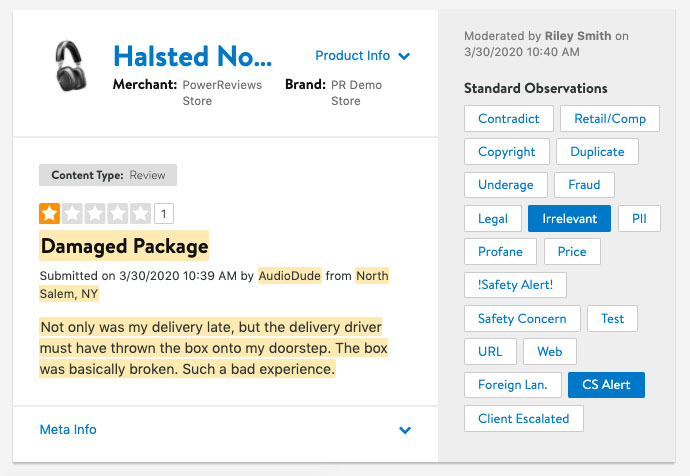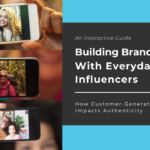We ran a webinar last month that explored the concept of “Everyday Influencers”, which is proving an extremely innovative and effective social media strategy for many brands. Our friends at Nautica spoke at length at the successes they have experienced.
In essence, Everyday Influencers are consumers with significantly smaller follower footprints than celebrities. But crucially, the followers they do have trust them implicitly. Think word of mouth recommendations from friends and family. This results in a far bigger impact overall, with authenticity an even more valuable quality than normal right now.
The topic clearly resonated as brands constantly reevaluate how they can get ahead in the everchanging social media environment. We actually had a ton of questions from brands and retailers that we were not able to get to. Here are a few of them and my responses:
What's the difference between an "everyday influencer" and a "micro influencer?"
A micro influencer is typically defined as having 1,000+ social media followers and accepting payments to create and amplify content. An everyday influencer typically has a few hundred followers and will generate authentic content in exchange for product samples. But they do not receive any financial payment - which makes a huge difference. This obviously has significant trust, authenticity and credibility implications.
Are “everyday influencers” getting paid?
A genuine everyday influencer community should not be receiving any financial payment for any reviews generated. At most, product samples and related accessories can be offered to the reviewer. While they can be guided about specific product attributes to focus on, they cannot be forced to leave positive reviews. The FTC governs all rules on review authenticity to ensure these conditions are upheld.
Isn’t that the strategy of legacy brands to hire celebrity ambassadors that drive to brand and speak to it?
This approach relies on a 2 step process: 1) create awareness and 2) drive to brand site. The second step doesn’t necessarily generate any trust as the marketing of the brand will always be consumed with an element of skepticism, unless the brand presents authentic feedback from consumers who have purchased or tried the product. For the cost of hiring a celebrity influencer, many everyday influencers could be employed instead - which generates awareness and immediately establishes trust with their audience, thereby accelerating the path to purchase.
Is verified purchases = trustworthy reviews = trust?
When a review is badged as being sourced from a verified purchaser, this automatically adds credibility. Consumers reading the review know that it’s come from someone who’s actually tried the product. They therefore process the content as being more trustworthy and not influenced by any payment to promote. So yes, this type of review generates trust.

How would you start using Everyday Influencers for a brand that is just starting out?
Start by understanding the category that the brand is being introduced into and the target profile of the ideal consumer for this brand. You may have this customer data already. But if you don’t, external vendors can help. Through our community lifestyle segments, demographic profiles and a craft qualifying survey, we at PowerReviews help brands isolate ideal consumers from within our community. The sheer size of our community ensures that even after filtering, the audience size is still sufficient enough to meet the needs of all our clients.
Do you know where/how consumers provide recommendations?
Consumers share product recommendations in a number of ways, including:
Although more brands are beginning to understand the value of everyday influencers, celebrity campaigns are still more popular. Do you think brands will shift more to activating everyday or nano to micro influencers?
Start by understanding the category that the brand is being introduced into and the target profile of the ideal consumer for this brand. You may have this customer data already. But if you don’t, external vendors can help. Through our community lifestyle segments, demographic profiles and a craft qualifying survey, we at PowerReviews help brands isolate ideal consumers from within our community. The sheer size of our community ensures that even after filtering, the audience size is still sufficient enough to meet the needs of all our clients.
If an influencer with 100,000 followers reposted an influencer who has only 1000 followers but is more authentic, how would that be perceived?
That’s an interesting one. I would expect it would be perceived extremely positively. Authenticity wins every time.
How much should we spend on a paid influencer campaign to make it worth our while if we have a pretty tight budget?
Brands should consider how much content is needed to generate authenticity and trust for their products. More high-valued products typically require more reviews. At a minimum, target 50 reviews and consider the average response rate for a sampling community to develop the ideal number of samples to distribute. If the average response rate is 85%, 100 samples will generate 85 reviews. Focus on the products that need content and are important to your portfolio. Also consider the recency of content. You may have a product with hundreds of reviews, but if they are older than 90 days, our studies show the Gen Z consumers tend to discount their value.

How do you handle trolls in direct consumer influencers posting?
You have two options. You either do it manually or you invest in some automated technology. At PowerReviews, we offer the best of both worlds. Our automated and human moderation processes ensure that content reaching consumers is as relevant and appropriate as possible. Brands should always respond to negative reviews so that consumers can see that brands are engaged. Brands should invest in generating content on a regular basis to help compensate for negative content.
What do you do when you want to reach new audiences outside of your already existing customer profile?
If a brand is looking to launch a new product that is not related to an existing product audience, leveraging everyday influencers through a large community is ideal. PowerReviews works with brands to build meaningful profiles for campaign participants. Using our existing lifestyle and demographic segments in tandem with surveys, brands find the right community members.
Do you think "everyday influencers" should be compensated for the branded content they produce for a brand?
No. As I say, authenticity wins every time. When financial incentives are involved in exchange for reviews, shoppers instantly discount the value of the review.Because the FTC requires that all reviews generated in exchange for any form of incentive must be disclosed in the review detail, there is no way around this.
What are some successful ways to report on ROI with influencers?
If you are looking to measure ROI, we have conducted numerous studies with Northwestern University that can be found here.
Could partnering with everyday influencers also be considered a good activity to implement in the context of Travel & Tourism services as opposed to Retail products?
Of course! Everyday influencers bring exceptional credibility to both products and services.
Have you seen success with tying PowerReviews with a specific retailer campaign?
Yes, one of our key retail partners uses the PowerReviews sampling community to execute sampling for reviews with its private label products. Our industry-leading high response rate (average 85%+) ensures an efficient spend against the costs of a sampling campaign (recruitment, product samples and fulfillment).
What are some proactive ways that you can engage these everyday influencers to create quality content for the brand? Is it possible to provide specific asks to these "loyal" consumers?
Asking everyday influencers to focus on specific product attributes or applications is definitely recommended to improve effectiveness. If you want to suggest locales or experiences in which to evaluate the product, that also can be included in the campaign details.
I have an emerging jewelry brand and I'd like to try working with Everyday Influencers. Could you suggest how to go about working with them?
As with any marketing activity, it’s all about accurately defining your target market and audience. You need to ensure you get your products in the hands of customers who are qualified and compelled to share with their own networks. At PowerReviews, we have a huge database of 100,000s everyday influencers. We can therefore match brands with the right influencers with precision to generate the best results.
What are the keys to contracting with micro and everyday influencers? Do you consider alternate payments (non-monetary)?
Micro influencers often require payment for reviews although they typically insist on delivering authentic, not necessarily positive reviews. Contracting them is often conducted on an individual basis. Everyday influencers are best managed through established sampling communities that offer genuine scale and where the third party has established credibility by not offering financial rewards in exchange for review writing.
Approximately how much time should I allocate to starting a relationship with an Everyday Influencer(s) and what have you seen worked out successfully?
Relationships with everyday influencers can be transactional or longitudinal. You can curate them for individual campaigns based on their needs. If you want to include influencers from previous campaigns, your sampling provider should manage all recruitment, minimizing any time effort on your part.

Influencers with high following don't necessarily have the most engagement. How do you look at influencers from an ROI perspective? And how do you prioritize awareness vs driving product sales through unique links?
Awareness and trust are not necessarily mutually exclusive. Instead of paying for one high-cost celebrity influencer to drive awareness, investing in everyday influencers with a cumulative reach at the same level is less expensive and generates far greater trust. If you are looking to measure ROI, we have conducted numerous studies with Northwestern University that can be found here.
You’ve talked a lot about trust, but how would you define it?
Trust is earned when a consumer reading a review decides that the author has offered a genuine product evaluation. If the reviewer is either verified or known by the reader, trust is far more likely.
If you want to know more about how PowerReviews helps companies generate consumer trust through everyday influencer campaigns, read our guide or watch the webinar recording.





